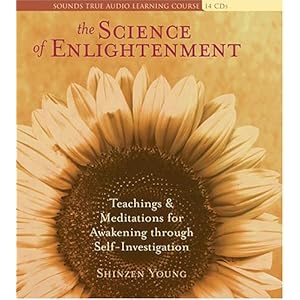I haven’t explicitly written about meditation in awhile, but readers still frequently send me e-mails asking me to recommend good programs to teach them how to do it.
For the sake of simplicity, here is a small list of the three that always pop to mind:
- Jon Kabat-Zinn’s “Guided Mindfulness Meditation.”
- Bhante Henepola Gunaratana’s “Mindfulness in Plain English.”
- Shinzen Young’s “The Science of Enlightenment.”
In this post, I want to elaborate specifically on Shinzen Young’s contribution in helping me learn meditation. I’ll tell you a little bit about Young’s credentials, his philosophy, and what “The Science of Enlightenment” offers to practitioners of meditation, as well as those who are just starting out.
The Science of Enlightenment
The Science of Enlightenment is a 14-CD set that spans over 16 hours of lectures and guided meditations. It covers a broad range of topics, starting with the theory and history of meditation practice, its emergence in Western culture, its relationship with science, and practical instruction for applying mindfulness and other mental skills to our everyday life.
Shinzen Young defines enlightenment as “a state of happiness independent of external conditions.” The goal of this program is to teach listeners about how this state of being can be achieved.
About Shinzen Young
Shinzen Young is a meditation teacher and an ordained monk in the Shingon Buddhist tradition. He has also practiced extensively in Zen and shamanism, and he is remarkably well-versed in all of today’s major religions including Christianity, Judaism, Hinduism, and Islam. He frequently integrates these different philosophies into his curriculum.
Despite Young’s spiritual and religious background however, his goal with The Science of Enlightenment is to develop a secular meditation practice that can be appreciated by a wider audience. His teachings therefore are largely compatible with theists and atheists alike.
Although Young makes use of religious scriptures and analogies to help drive the theoretical framework of his teachings, he also loves drawing connections between scientific and mathematical concepts to help explain different facets of meditation. Young also has a particular interest in neuroscience, which has led to collaborations with researchers at UCLA and the University of Wisconsin.
The curriculum in The Science of Enlightenment is part theory and part practical, and both are necessary in developing a full understanding of Young’s teachings. Some of the themes Young focuses on are:
- The importance of self-investigation.
- Common traps during meditation.
- The application of mindfulness and equanimity to daily life.
- Research about meditation and brain-wave states, biofeedback, stress, and aging.
- How meditation enhances learning, athletic performance, relationships, and emotional life.
- The history of awakening practices – from their Tribal roots to their relevance in today’s world and the Information Age.
At times the material can get advanced and technical, especially the theoretical parts. But the real beauty in Young’s work is his ability to weave effortlessly between personal stories, historical events, analogies, and scientific studies in a way that can appeal to almost anyone of any demographic or educational background. While listening, there may be times where you get lost or confused. But eventually you’ll find moments where things begin to “click.”
Like all educational material, you will have to re-listen to some tracks before you can digest everything.
One complaint I’ve seen from some listeners is that Young’s stories sometimes get too personal. For example, in one lecture he tells of a series of experiences where he hallucinated gigantic, highly realistic insects wherever he went. Material like this that can occasionally scare away novice practitioners of meditation. However, in my opinion these personal anecdotes are some of the best material Young offers; he uses his own experience as an educational tool for those who may experience common setbacks during their own practice. It is this kind of sincerity and openness that I think really gives The Science of Enlightenment its unique value compared to other programs.
The Recording of The Science of Enlightenment
I think one reason Shinzen Young’s talks are so captivating during these lectures is because of the way it was recorded. He didn’t just read from a prepared script in a lonely studio. Instead, he first wrote down a general layout on index cards, and then invited 12 or so guests to listen to him speak for about a week. This gives the recordings a feel of spontaneity and being “in the moment.”
Young describes his talks as a “brain dump of my understanding of the meditation path.” After which the studio spent months editing the material to finally present you the final presentation.
Watch Young as he explains the process in his own words:
Why learn meditation at all?
At this point you may still be wondering, “Why should I learn meditation at all? Isn’t meditation just sitting around and doing nothing?”
Of course, it may seem like that from an outside perspective. It may seem like the most unproductive and useless way to spend your time. However, meditation is becoming more and more popular everyday because it works, and people see results from inside to outside.
Meditation helps you think more clearly, it helps you become more aware of your emotions and your environment, and it improves productivity, creativity, and relationships among so much more.
More and more research is being done on meditation every year. Between 2000-2010 over 48,000 academic articles have covered the subject. We are still learning new things every year about how it affects health and well-being.
Enter your email to stay updated on new articles in self improvement:

